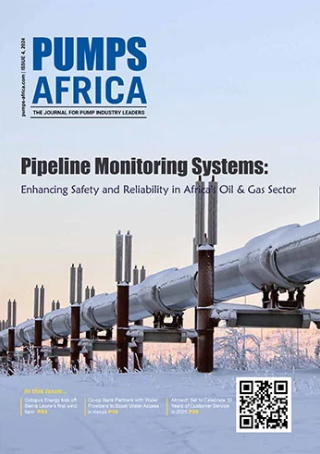For water to truly be utilised without harm it needs to be clean, and the fact is that fresh water is not an infinite resource. This has been emphasised over the last decade by the increase in intensity of climate variability and resultant impact of extreme weather events on available surface water resources.
Additionally, continuous and rapid urbanisation is placing strain on water resources and infrastructure networks alike across much of Africa. Fresh water used in industrial and process applications that is not remediated properly before being discharged back into local sewerage systems is also a heavy contributor to water pollution, placing further pressure on water resources and treatment plants.
Sustaining all life on Earth is intrinsically dependent on responsible water management – and while there are many and complex aspects involved with a circular approach to complete water management there can be no doubt that successful water treatment of wastewater is essential for the sustainability of water resources, and our planet.
Wastewater encompasses a broad spectrum, including drainage from households, commercial establishments, hospitals and industries. It also includes stormwater and urban runoff, along with agricultural, horticultural, and aquaculture effluent. Untreated, dirty water gets released into natural water reservoirs, where it wreaks havoc on fish, animals and crops. This water evaporates, and ultimately the resulting rainwater is also largely contaminated.
As it currently stands, however, wastewater treatment is not being fully leveraged. According to the UN, approximately 80% of wastewater is released into the environment without being recycled or adequately treated. This only increases the risk of contamination to potable and drinking water.
Furthermore, failing to fully utilise efficient wastewater treatment has a deleterious impact on socioeconomic issues, impeding sustainable economic development.
Effectively utilising wastewater is not only essential to environmental conservation and a smart way to address water shortages, but also potentially a resource, from which water, energy, nutrients and a variety of recoverable materials can be garnered.
Beyond that, it can also serve as a marketable commodity in its own right. According to the UN Environmental Programme, and the Global Wastewater Initiative, there is 330 of municipal wastewater being generated globally each year. If this wastewater could be managed effectively, the resources embedded in this water could be used to irrigate and fertilise millions of hectares of crops, as well as produce biogas that could supply energy for millions of households.
One of the reasons given why wastewater isn’t treated to its full capacity is because of the cost associated with upgrading wastewater treatment systems. However, the Environmental Protection Agency in the US notes that this can be mitigated, as plant upgrades can pay for themselves or end up saving a plant money.
Wastewater treatment plant design engineers have a huge responsibility and stake in the management of diminishing water resources – and when designing new and upgrading existing infrastructure, they should be very careful of false economy when setting the standard for their pump requirements.
Engineers have difficult questions to ask themselves. For example, “are we going to ask for the minimum specification that will perform the duties and meet compliance for a lower initial cost, or is there any benefit in selecting a pump with a higher initial cost that might be over-engineered in the short-term, but there is the potential for savings when the entire lifecycle of the pump is considered?”
Many factors should influence the decisions when plant equipment is considered, with budgetary constraints many of these factors are often overlooked. CAPEX versus OPEX studies should be extensive in the planning and implementation of new treatment facilities, as well as managing and operating existing treatment facilities.
For instance, when upgrading aging infrastructure, new and improved technologies should be explored and considered instead of just replacing equipment like-for-like. The process should constantly be assessed and viewed in its entirety, and ultimately developed, refined and improved adopting modern and more economical solutions to better overall plant efficiency and efficacy.
Additionally, there are technological developments that can help reduce costs associated with maintenance and improve plant uptime, such as a technology called peristaltic pumping, that is both efficient and cost-effective.
Over time, this has evolved from familiar lower pressure, low flow medical devices into heavy duty, medium pressure industrial pumping solutions that mimic the well proven principle of peristalsis found in the human body. Hose pumps are an essentially simple technology, using a specially designed, re-enforced rubber hose that is repeatedly compressed by a rotating pressing shoe and then allowed to relax. This action results in a simple positive displacement pumping mechanism with a powerful, high vacuum suction, dry priming action.
The key factor in wastewater treatment applications, is that the pumped medium, for example, lime, flocculant or other dosing chemicals – is always contained within the tube and never allowed to come into contact with any of the pump’s moving parts. There are no valves, glands or seals for the pumped medium to affect, which often account for the weak points on other pump types. This brings significant benefits in eliminating much of the process downtime and maintenance costs, as the only component that may need to be replaced with any sort of frequency will be the flexible hose.
Doing so effectively returns the pump to ‘as new’ condition. Additionally, these pumps;
- Are cost effective when the entire life cycle cost is considered, as well as less overall maintenance costs and downtime – providing a higher return on capital,
- Use less space and power, than other conventional pumps,
- May be operated continuously without any problems, meaning that process operations do not need to be interrupted,
- Contribute to boosting operational efficiencies, and
- Pose less risk of leakages, by eliminating leaking seals, which also means there is less waste or contaminants impacting the natural environment.
Data from the EPA notes that some wastewater treatment plants are able to remove more nitrogen and phosphorus from their discharges than others depending on their equipment and how they treat wastewater. This suggests that there is room for progress and improvement, which bodes well for better and more economical wastewater treatment.
The result in doing so is clear – not only would it go a long way to addressing environmental sustainability, but also sparing us from the nightmare scenario of running out of the precious resource that is drinkable water, which is absolutely indispensable to our health, recreation and social and economic progress.







